|
Recently, Audi has made their presence felt in North American professional sports car
racing but long-time fans of IMSA (International Motor Sports Association) know that this is not their first foray into the series. After winning the
1988 Trans Am Driver’s and Manufacturer’s Championship Audi entered the 1989 IMSA GT series. Audi management said that the move from the SCCA (Sports
Car Club of America) Pro series to IMSA was a result of the rules. As the IMSA regulations were more liberal, it was suggested that they would allow
Audi to investigate new areas of technology, which would eventually be used in their production vehicles.
In the ‘80s, Audi was under the direction of Dr. Ferdinand Piech whose guidance led the company to be one of
the most influential car manufacturers. It was during this period that they initiated two major advancements in automotive design - all-wheel-drive and
applied aerodynamics. The first Quattro coupe was introduced in March 1980 at the Geneva Motor Show. Combining permanent four-wheel drive with a
performance car concept generated a tremendous amount of excitement among motoring enthusiasts. Prior to this four-wheel drive technology was mainly
reserved for off-road vehicles - usually trucks. This combination not only resulted in an outstanding road car but also provided Audi with the World
Rally Championship in 1982 and 84. Audi’s development of four-wheel drive technology was followed by a focus on aerodynamics. The manufacturer applied
aerodynamic principles to reduce the drag of their cars. The 1982 European spec Audi 100 was reported to have a drag coefficient of 0.30. These influences
continue to be seen in not only Audi’s current offerings but those of other manufacturers. To compete in the 1989 IMSA GT series, Audi developed a 90
Turbo Quattro model, which took advantage of their applied aerodynamic and all-wheel-drive knowledge.
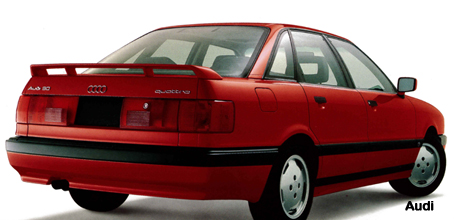 There were two versions of the 1989 Audi 90 - the standard model simply called the 90 and the 90 Quattro.
The two models shared many common features. A 2.3-liter five-cylinder overhead cam engine powered the 90s. The fuel injected motor produced 130-horsepower
and 140-ft.lbs. of torque. The cars came standard with a 5-speed transmission, however, the Quattro was equipped with a closed ratio sport model. An
automatic transmission was offered as an option in the regular 90 but not the Quattro. To stop the car, Audi fitted ABS power assisted disc Brakes -
on the front were vented rotors on the front and the rear had solid discs. The cars were equipped with 14-inch wheels and the original tires were
195/60VR14 steel belted radials. The steering system was a power-assisted rack and pinion with just over three rotations required to turn lock to lock.
MacPherson struts were used on the front suspension, which was also equipped with a stabilizer bar. The rear suspension differed between the two models.
The standard version of the 90 used a torsion crank rear axle with panhard rod and coil spring-shock absorber strut design. To accommodate the
all-wheel-drive the Quattro used an independent rear suspension, which incorporated a coil spring/shock absorber strut setup. Additional features
differentiated the Quattro from its standard counterpart - interior styling, a rear spoiler and a larger gas tank. But the most unique characteristic
of the Quattro was the permanent all-wheel-drive. The system constantly distributed power to all four wheels, reducing the chance of wheel-spin and
enhancing traction. The TORSEN (TORque SENsing by the Gleason Corporation) center differential apportioned more engine power to the axle with the most
traction. This feature allowed Audi to set the Quattro apart from its competitors in the sports sedan market.
There were two versions of the 1989 Audi 90 - the standard model simply called the 90 and the 90 Quattro.
The two models shared many common features. A 2.3-liter five-cylinder overhead cam engine powered the 90s. The fuel injected motor produced 130-horsepower
and 140-ft.lbs. of torque. The cars came standard with a 5-speed transmission, however, the Quattro was equipped with a closed ratio sport model. An
automatic transmission was offered as an option in the regular 90 but not the Quattro. To stop the car, Audi fitted ABS power assisted disc Brakes -
on the front were vented rotors on the front and the rear had solid discs. The cars were equipped with 14-inch wheels and the original tires were
195/60VR14 steel belted radials. The steering system was a power-assisted rack and pinion with just over three rotations required to turn lock to lock.
MacPherson struts were used on the front suspension, which was also equipped with a stabilizer bar. The rear suspension differed between the two models.
The standard version of the 90 used a torsion crank rear axle with panhard rod and coil spring-shock absorber strut design. To accommodate the
all-wheel-drive the Quattro used an independent rear suspension, which incorporated a coil spring/shock absorber strut setup. Additional features
differentiated the Quattro from its standard counterpart - interior styling, a rear spoiler and a larger gas tank. But the most unique characteristic
of the Quattro was the permanent all-wheel-drive. The system constantly distributed power to all four wheels, reducing the chance of wheel-spin and
enhancing traction. The TORSEN (TORque SENsing by the Gleason Corporation) center differential apportioned more engine power to the axle with the most
traction. This feature allowed Audi to set the Quattro apart from its competitors in the sports sedan market.
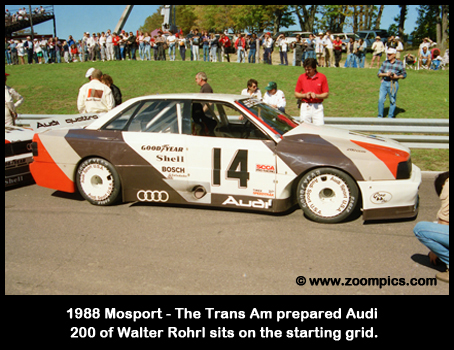 The Audi’s entered in the 1988 Trans Am series were heavily modified production versions of the 200 Turbo
Quattro. However, a difference in the rules between SCCA and IMSA allowed Audi much more leeway in the construction of their latest race car. Responsibility
for the project was given to, Audi’s Special Vehicles Manager, Josef Hoppen. Hoppen had a tremendous amount of motorsports experience. His resume included
the head of motorsport for Volkswagen of America, which meant overseeing the competition departments of Porsche, Audi and Volkswagen He was credited with much
of Porsche’s dominance in the SCCA’s Cam-Am and Trans-Am series and the IMSA Camel GT Championship.
The Audi’s entered in the 1988 Trans Am series were heavily modified production versions of the 200 Turbo
Quattro. However, a difference in the rules between SCCA and IMSA allowed Audi much more leeway in the construction of their latest race car. Responsibility
for the project was given to, Audi’s Special Vehicles Manager, Josef Hoppen. Hoppen had a tremendous amount of motorsports experience. His resume included
the head of motorsport for Volkswagen of America, which meant overseeing the competition departments of Porsche, Audi and Volkswagen He was credited with much
of Porsche’s dominance in the SCCA’s Cam-Am and Trans-Am series and the IMSA Camel GT Championship.
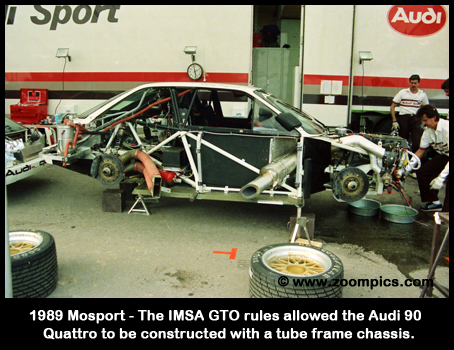 The new racer used a tube frame design, which allowed for a revised suspension that incorporated double wishbone arms and coil-over shock absorbers.
This construction also allowed the engine to be moved further back towards the center of the car for better weight distribution. Of course, the most
interesting features of Audi Quattro’s is the all-wheel-drive system. The central differential was a self-locking TORSEN. The front differential was a
limited-slip setup with a viscous coupling whereas the rear used a multi-plate coupling. Audi described the arrangement used on the IMSA cars as an
extremely advanced version of the current production system. This feature caused the greatest amount of concern amongst competitors. As the
all-wheel-drive system would provide a distinct advantage in adverse conditions.
The new racer used a tube frame design, which allowed for a revised suspension that incorporated double wishbone arms and coil-over shock absorbers.
This construction also allowed the engine to be moved further back towards the center of the car for better weight distribution. Of course, the most
interesting features of Audi Quattro’s is the all-wheel-drive system. The central differential was a self-locking TORSEN. The front differential was a
limited-slip setup with a viscous coupling whereas the rear used a multi-plate coupling. Audi described the arrangement used on the IMSA cars as an
extremely advanced version of the current production system. This feature caused the greatest amount of concern amongst competitors. As the
all-wheel-drive system would provide a distinct advantage in adverse conditions.
The connection between the all-wheel-drive system and engine was made using an all-synchromesh 6-speed
transmission. One of the gears was disabled as IMSA rules limited the number of forward gears to five. The driveline also incorporated a twin plate
clutch.
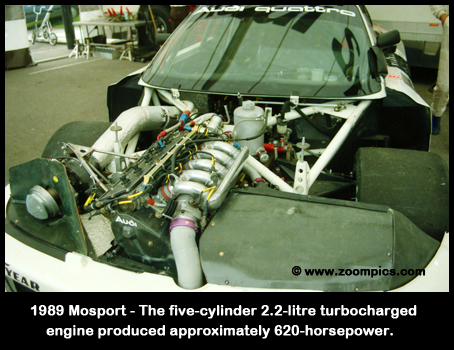 Another unique design feature of Audi’s is their engines. The car was equipped with a five-cylinder 2.2-
liter turbocharged motor that had 4-valves per cylinder. The electronics for the engine was controlled by a Bosch Motronic MP 1.7 system. A dry sump
system, which held 12.6 quarts of oil, was used to lubricate the motor. These features and the IMSA engine rules allowed Audi to generate an
additional 110-horsepower (from 510-horsepower to 620-horsepower) over the Trans Am prepared engines.
Another unique design feature of Audi’s is their engines. The car was equipped with a five-cylinder 2.2-
liter turbocharged motor that had 4-valves per cylinder. The electronics for the engine was controlled by a Bosch Motronic MP 1.7 system. A dry sump
system, which held 12.6 quarts of oil, was used to lubricate the motor. These features and the IMSA engine rules allowed Audi to generate an
additional 110-horsepower (from 510-horsepower to 620-horsepower) over the Trans Am prepared engines.
The cars were equipped with four-piston calipers and ventilated rotors, which featured carbon fiber brake
pads for extended life and better stopping. Fourteen-inch diameter alloy wheels - 17-inches wide were fitted with Goodyear racing tires.
| 1989 AUDI 90 QUATTRO - TECHNICAL DATA |
| ENGINE | 90 QUATTRO | 90 QUATTRO IMSA GTO |
| Type | 5-cylinder in-line | 5-cylinder in-line |
| Displacement | 2309 cc (141 cu.in.) | 2190 cc (133.6 cu.in.) |
| Bore and Stroke | 3.25 in. x 3.40 in. | 3.19 in. x 3.35 in. |
| Turbocharger | - | KKK with intercooler |
| Horsepower | 130 @ 5700 RPM | 620 @ 7500 RPM |
| Torque | 140 ft. lbs. @ 4500 RPM | 438 ft. lbs. @ 6000 RPM |
| SUSPENSION |
| Steering Ratio | 16.8:1 | 14.5:1 |
| Type | Rack & pinion, power-assisted | Rack & pinion, power-assisted |
| Front | MacPherson strut | Double wishbone |
| Rear | Coil-over struts | Double wishbone |
| Wheels | 6" x 14" | 14" x 17" |
| Tires | 195/60VR14 | 25.5" x 14.0" - 17" |
| BRAKES |
| Front Rotors | 10.1" - ventilated discs | 13" - ventilated discs |
| Rear Rotors | 9.6" - solid discs | 13" - ventilated discs |
| BODY |
| Chassis | Unitized body/chassis | Tube frame with Kevlar body |
| DIMENSIONS |
| Length | 176.3 in. | 176.4 in. |
| Width | 66.7 in. | 78.7 in. |
| Height | 54.8 in. | 48.1 in. |
| Wheelbase | 99.9 in. | 99.9 in. |
| Front Track | 55.6 in. | 66.1 in. |
| Rear Track | 56.3 in. | 66.1 in. |
| Weight | 2948 lbs. | 2660 lbs. |
| FLUID CAPACITIES |
| Oil | 3.7 quarts | 12.6 quarts |
| Cooling | 8.5 quarts | 8.5 quarts |
| Fuel | 18.5 gallons | 31.7 gallons |
In 1989, there were three different classes in the IMSA GT series - GTO, GTU and the American Challenge. A
variety of rules and regulations distinguished the categories but all three were based on production vehicles. GTO stood for "Grand Touring Over"
three-liters in engine displacement, however, a variety of engine configurations and displacements were utilized. Engine size was restricted to six-liters
for normally aspirated motors and turbocharged engines could not exceed three-liters. The 90 Turbo Quattro would compete in this class.
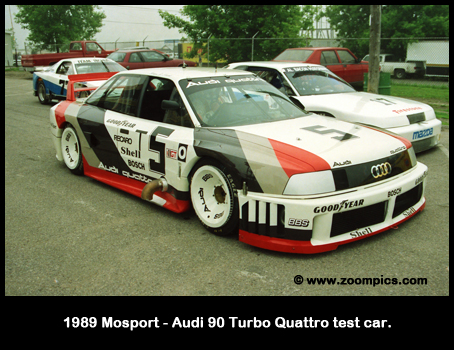 Hurley Haywood and Hans Stuck were selected by Audi to lead their assault on the 1989 IMSA GT series.
Haywood had won the 1988 Trans Am championship driving an all-wheel-drive Audi 200 Turbo Quattro. His professional career began in 1971 in a Porsche
914/6 in the then newly formed IMSA Camel GT tour. Sharing the car with his mentor, Peter Gregg, he was named co-champion of the series. The following
year he won the crown outright. In the years to follow he would win the 24 hours of Daytona four times and Le Mans twice. Haywood’s first involvement
with Audi occurred in 1987, winning the Road Atlanta and Mid-Ohio SCCA Escort Endurance rounds.
Hans Stuck also drove with Audi in the 1988 Trans Am series - taking wins at Cleveland, Brainerd, the Meadowlands and Mid-Ohio. Stuck’s career to this
point included Formula One experience, the 1985 World Endurance crown and wins at Le Mans and Sebring. Brought in for the longer races were Scott Goodyear
and Walter Roehrl. The Canadian Goodyear had won the 1986 Formula Atlantic title and had a tremendous amount of experience in both open and closed wheel
cars. He was partnered with Haywood at Mosport and Road America. Walter Roehrl also competed in the 1988 Trans Am championship for Audi taking wins at
Niagara Falls and St. Petersburg. However, Roehrl’s real claim to fame was his Rally experience. He had multiple Monte Carlo triumphs, World Rally titles
and even won Pikes Peak. Roehrl shared driving duties at Watkins Glen and Road America with Stuck.
Hurley Haywood and Hans Stuck were selected by Audi to lead their assault on the 1989 IMSA GT series.
Haywood had won the 1988 Trans Am championship driving an all-wheel-drive Audi 200 Turbo Quattro. His professional career began in 1971 in a Porsche
914/6 in the then newly formed IMSA Camel GT tour. Sharing the car with his mentor, Peter Gregg, he was named co-champion of the series. The following
year he won the crown outright. In the years to follow he would win the 24 hours of Daytona four times and Le Mans twice. Haywood’s first involvement
with Audi occurred in 1987, winning the Road Atlanta and Mid-Ohio SCCA Escort Endurance rounds.
Hans Stuck also drove with Audi in the 1988 Trans Am series - taking wins at Cleveland, Brainerd, the Meadowlands and Mid-Ohio. Stuck’s career to this
point included Formula One experience, the 1985 World Endurance crown and wins at Le Mans and Sebring. Brought in for the longer races were Scott Goodyear
and Walter Roehrl. The Canadian Goodyear had won the 1986 Formula Atlantic title and had a tremendous amount of experience in both open and closed wheel
cars. He was partnered with Haywood at Mosport and Road America. Walter Roehrl also competed in the 1988 Trans Am championship for Audi taking wins at
Niagara Falls and St. Petersburg. However, Roehrl’s real claim to fame was his Rally experience. He had multiple Monte Carlo triumphs, World Rally titles
and even won Pikes Peak. Roehrl shared driving duties at Watkins Glen and Road America with Stuck.
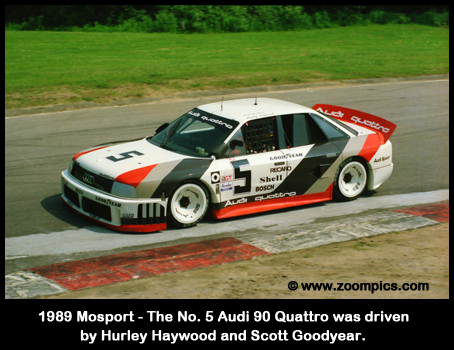 The IMSA GT season opened with the SunBank 24 at Daytona in February, however, the Audi team missed this
event. The next round at Miami saw the debut of the new all-wheel-drive Audi 90 Turbo Quattro. Unfortunately, cars retired early - Haywood had an
accident and Stuck went out with transmission problems. The team would skip Sebring, however, they would return with a vengeance for the fourth round
at Summit Point. Hans Stuck took the win leading his teammate Haywood across the line by 3.9 seconds. This was quite a wake-up call for the series
point leaders - Pete Halsmer and Wally Dallenbach driving the Roush Racing Mercury Cougar XR-7s.
The IMSA GT season opened with the SunBank 24 at Daytona in February, however, the Audi team missed this
event. The next round at Miami saw the debut of the new all-wheel-drive Audi 90 Turbo Quattro. Unfortunately, cars retired early - Haywood had an
accident and Stuck went out with transmission problems. The team would skip Sebring, however, they would return with a vengeance for the fourth round
at Summit Point. Hans Stuck took the win leading his teammate Haywood across the line by 3.9 seconds. This was quite a wake-up call for the series
point leaders - Pete Halsmer and Wally Dallenbach driving the Roush Racing Mercury Cougar XR-7s.
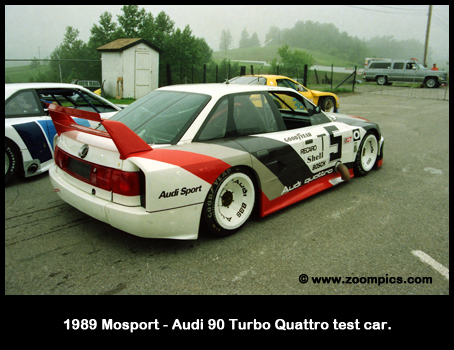 Mid-Ohio was the site of the fifth race in the championship - Stuck took his second win and was followed by Dallenbach and John Morton driving the Clayton
Cunningham Nissan 300ZX. Haywood was able to manage a fifth place finish just behind Halsmer. The next round was at Mosport where the Audi’s experienced
mechanical problems - Stuck failed to score any points and the Haywood/Goodyear combination finished down the order after the team was required to deal
with a recurring oil leak. Retirements and poor finishes at Miami, Mosport and the final round at Del Mar would be the low points in the season for
the team. The remainder of the races saw, at least, one Audi in the top five. In fact, Stuck and Haywood were able to finish first and second at Topeka,
Sears Point, Watkins Glen, Laguna Seca and take a first and third at Lime Rock.
Mid-Ohio was the site of the fifth race in the championship - Stuck took his second win and was followed by Dallenbach and John Morton driving the Clayton
Cunningham Nissan 300ZX. Haywood was able to manage a fifth place finish just behind Halsmer. The next round was at Mosport where the Audi’s experienced
mechanical problems - Stuck failed to score any points and the Haywood/Goodyear combination finished down the order after the team was required to deal
with a recurring oil leak. Retirements and poor finishes at Miami, Mosport and the final round at Del Mar would be the low points in the season for
the team. The remainder of the races saw, at least, one Audi in the top five. In fact, Stuck and Haywood were able to finish first and second at Topeka,
Sears Point, Watkins Glen, Laguna Seca and take a first and third at Lime Rock.
By the end of the season, Stuck had claimed seven wins and was followed by Halsmer with five and Dallenbach had four to his credit. In spite of Stuck’s
wins and the contribution of his teammates to the points tally, Audi would fall short of the Manufacturer’s and Driver’s titles. The Cougar’s had scored
points in every race whereas the Audi’s had failed to match this feat as the result of missing two events early in the season and retirements at two
others. Peter Halsmer and Wally Dallenbach finish first and second in the Driver’s Championship giving the Mercury the Manufacturer’s title. Audi
finished second in the Manufacturer’s Championship and Stuck and Haywood took third and fourth in the Driver’s standings. As has been known to happen
in motorsports, the corporate strategy changed and despite so much promise Audi decided to withdraw from the IMSA series and pursue the German Touring Car
Championship (DTM). Driving an Audi V8 Quattro Hans Stuck won the title in his first attempt. With a year of experience behind them who knows what the
outcome may have been if Audi had decided to compete in the 1990 IMSA GTO Championship.
|
 There were two versions of the 1989 Audi 90 - the standard model simply called the 90 and the 90 Quattro.
The two models shared many common features. A 2.3-liter five-cylinder overhead cam engine powered the 90s. The fuel injected motor produced 130-horsepower
and 140-ft.lbs. of torque. The cars came standard with a 5-speed transmission, however, the Quattro was equipped with a closed ratio sport model. An
automatic transmission was offered as an option in the regular 90 but not the Quattro. To stop the car, Audi fitted ABS power assisted disc Brakes -
on the front were vented rotors on the front and the rear had solid discs. The cars were equipped with 14-inch wheels and the original tires were
195/60VR14 steel belted radials. The steering system was a power-assisted rack and pinion with just over three rotations required to turn lock to lock.
MacPherson struts were used on the front suspension, which was also equipped with a stabilizer bar. The rear suspension differed between the two models.
The standard version of the 90 used a torsion crank rear axle with panhard rod and coil spring-shock absorber strut design. To accommodate the
all-wheel-drive the Quattro used an independent rear suspension, which incorporated a coil spring/shock absorber strut setup. Additional features
differentiated the Quattro from its standard counterpart - interior styling, a rear spoiler and a larger gas tank. But the most unique characteristic
of the Quattro was the permanent all-wheel-drive. The system constantly distributed power to all four wheels, reducing the chance of wheel-spin and
enhancing traction. The TORSEN (TORque SENsing by the Gleason Corporation) center differential apportioned more engine power to the axle with the most
traction. This feature allowed Audi to set the Quattro apart from its competitors in the sports sedan market.
There were two versions of the 1989 Audi 90 - the standard model simply called the 90 and the 90 Quattro.
The two models shared many common features. A 2.3-liter five-cylinder overhead cam engine powered the 90s. The fuel injected motor produced 130-horsepower
and 140-ft.lbs. of torque. The cars came standard with a 5-speed transmission, however, the Quattro was equipped with a closed ratio sport model. An
automatic transmission was offered as an option in the regular 90 but not the Quattro. To stop the car, Audi fitted ABS power assisted disc Brakes -
on the front were vented rotors on the front and the rear had solid discs. The cars were equipped with 14-inch wheels and the original tires were
195/60VR14 steel belted radials. The steering system was a power-assisted rack and pinion with just over three rotations required to turn lock to lock.
MacPherson struts were used on the front suspension, which was also equipped with a stabilizer bar. The rear suspension differed between the two models.
The standard version of the 90 used a torsion crank rear axle with panhard rod and coil spring-shock absorber strut design. To accommodate the
all-wheel-drive the Quattro used an independent rear suspension, which incorporated a coil spring/shock absorber strut setup. Additional features
differentiated the Quattro from its standard counterpart - interior styling, a rear spoiler and a larger gas tank. But the most unique characteristic
of the Quattro was the permanent all-wheel-drive. The system constantly distributed power to all four wheels, reducing the chance of wheel-spin and
enhancing traction. The TORSEN (TORque SENsing by the Gleason Corporation) center differential apportioned more engine power to the axle with the most
traction. This feature allowed Audi to set the Quattro apart from its competitors in the sports sedan market.
 The Audi’s entered in the 1988 Trans Am series were heavily modified production versions of the 200 Turbo
Quattro. However, a difference in the rules between SCCA and IMSA allowed Audi much more leeway in the construction of their latest race car. Responsibility
for the project was given to, Audi’s Special Vehicles Manager, Josef Hoppen. Hoppen had a tremendous amount of motorsports experience. His resume included
the head of motorsport for Volkswagen of America, which meant overseeing the competition departments of Porsche, Audi and Volkswagen He was credited with much
of Porsche’s dominance in the SCCA’s Cam-Am and Trans-Am series and the IMSA Camel GT Championship.
The Audi’s entered in the 1988 Trans Am series were heavily modified production versions of the 200 Turbo
Quattro. However, a difference in the rules between SCCA and IMSA allowed Audi much more leeway in the construction of their latest race car. Responsibility
for the project was given to, Audi’s Special Vehicles Manager, Josef Hoppen. Hoppen had a tremendous amount of motorsports experience. His resume included
the head of motorsport for Volkswagen of America, which meant overseeing the competition departments of Porsche, Audi and Volkswagen He was credited with much
of Porsche’s dominance in the SCCA’s Cam-Am and Trans-Am series and the IMSA Camel GT Championship.
 The new racer used a tube frame design, which allowed for a revised suspension that incorporated double wishbone arms and coil-over shock absorbers.
This construction also allowed the engine to be moved further back towards the center of the car for better weight distribution. Of course, the most
interesting features of Audi Quattro’s is the all-wheel-drive system. The central differential was a self-locking TORSEN. The front differential was a
limited-slip setup with a viscous coupling whereas the rear used a multi-plate coupling. Audi described the arrangement used on the IMSA cars as an
extremely advanced version of the current production system. This feature caused the greatest amount of concern amongst competitors. As the
all-wheel-drive system would provide a distinct advantage in adverse conditions.
The new racer used a tube frame design, which allowed for a revised suspension that incorporated double wishbone arms and coil-over shock absorbers.
This construction also allowed the engine to be moved further back towards the center of the car for better weight distribution. Of course, the most
interesting features of Audi Quattro’s is the all-wheel-drive system. The central differential was a self-locking TORSEN. The front differential was a
limited-slip setup with a viscous coupling whereas the rear used a multi-plate coupling. Audi described the arrangement used on the IMSA cars as an
extremely advanced version of the current production system. This feature caused the greatest amount of concern amongst competitors. As the
all-wheel-drive system would provide a distinct advantage in adverse conditions.
 Another unique design feature of Audi’s is their engines. The car was equipped with a five-cylinder 2.2-
liter turbocharged motor that had 4-valves per cylinder. The electronics for the engine was controlled by a Bosch Motronic MP 1.7 system. A dry sump
system, which held 12.6 quarts of oil, was used to lubricate the motor. These features and the IMSA engine rules allowed Audi to generate an
additional 110-horsepower (from 510-horsepower to 620-horsepower) over the Trans Am prepared engines.
Another unique design feature of Audi’s is their engines. The car was equipped with a five-cylinder 2.2-
liter turbocharged motor that had 4-valves per cylinder. The electronics for the engine was controlled by a Bosch Motronic MP 1.7 system. A dry sump
system, which held 12.6 quarts of oil, was used to lubricate the motor. These features and the IMSA engine rules allowed Audi to generate an
additional 110-horsepower (from 510-horsepower to 620-horsepower) over the Trans Am prepared engines.
 Hurley Haywood and Hans Stuck were selected by Audi to lead their assault on the 1989 IMSA GT series.
Haywood had won the 1988 Trans Am championship driving an all-wheel-drive Audi 200 Turbo Quattro. His professional career began in 1971 in a Porsche
914/6 in the then newly formed IMSA Camel GT tour. Sharing the car with his mentor, Peter Gregg, he was named co-champion of the series. The following
year he won the crown outright. In the years to follow he would win the 24 hours of Daytona four times and Le Mans twice. Haywood’s first involvement
with Audi occurred in 1987, winning the Road Atlanta and Mid-Ohio SCCA Escort Endurance rounds.
Hans Stuck also drove with Audi in the 1988 Trans Am series - taking wins at Cleveland, Brainerd, the Meadowlands and Mid-Ohio. Stuck’s career to this
point included Formula One experience, the 1985 World Endurance crown and wins at Le Mans and Sebring. Brought in for the longer races were Scott Goodyear
and Walter Roehrl. The Canadian Goodyear had won the 1986 Formula Atlantic title and had a tremendous amount of experience in both open and closed wheel
cars. He was partnered with Haywood at Mosport and Road America. Walter Roehrl also competed in the 1988 Trans Am championship for Audi taking wins at
Niagara Falls and St. Petersburg. However, Roehrl’s real claim to fame was his Rally experience. He had multiple Monte Carlo triumphs, World Rally titles
and even won Pikes Peak. Roehrl shared driving duties at Watkins Glen and Road America with Stuck.
Hurley Haywood and Hans Stuck were selected by Audi to lead their assault on the 1989 IMSA GT series.
Haywood had won the 1988 Trans Am championship driving an all-wheel-drive Audi 200 Turbo Quattro. His professional career began in 1971 in a Porsche
914/6 in the then newly formed IMSA Camel GT tour. Sharing the car with his mentor, Peter Gregg, he was named co-champion of the series. The following
year he won the crown outright. In the years to follow he would win the 24 hours of Daytona four times and Le Mans twice. Haywood’s first involvement
with Audi occurred in 1987, winning the Road Atlanta and Mid-Ohio SCCA Escort Endurance rounds.
Hans Stuck also drove with Audi in the 1988 Trans Am series - taking wins at Cleveland, Brainerd, the Meadowlands and Mid-Ohio. Stuck’s career to this
point included Formula One experience, the 1985 World Endurance crown and wins at Le Mans and Sebring. Brought in for the longer races were Scott Goodyear
and Walter Roehrl. The Canadian Goodyear had won the 1986 Formula Atlantic title and had a tremendous amount of experience in both open and closed wheel
cars. He was partnered with Haywood at Mosport and Road America. Walter Roehrl also competed in the 1988 Trans Am championship for Audi taking wins at
Niagara Falls and St. Petersburg. However, Roehrl’s real claim to fame was his Rally experience. He had multiple Monte Carlo triumphs, World Rally titles
and even won Pikes Peak. Roehrl shared driving duties at Watkins Glen and Road America with Stuck.
 The IMSA GT season opened with the SunBank 24 at Daytona in February, however, the Audi team missed this
event. The next round at Miami saw the debut of the new all-wheel-drive Audi 90 Turbo Quattro. Unfortunately, cars retired early - Haywood had an
accident and Stuck went out with transmission problems. The team would skip Sebring, however, they would return with a vengeance for the fourth round
at Summit Point. Hans Stuck took the win leading his teammate Haywood across the line by 3.9 seconds. This was quite a wake-up call for the series
point leaders - Pete Halsmer and Wally Dallenbach driving the Roush Racing Mercury Cougar XR-7s.
The IMSA GT season opened with the SunBank 24 at Daytona in February, however, the Audi team missed this
event. The next round at Miami saw the debut of the new all-wheel-drive Audi 90 Turbo Quattro. Unfortunately, cars retired early - Haywood had an
accident and Stuck went out with transmission problems. The team would skip Sebring, however, they would return with a vengeance for the fourth round
at Summit Point. Hans Stuck took the win leading his teammate Haywood across the line by 3.9 seconds. This was quite a wake-up call for the series
point leaders - Pete Halsmer and Wally Dallenbach driving the Roush Racing Mercury Cougar XR-7s.
 Mid-Ohio was the site of the fifth race in the championship - Stuck took his second win and was followed by Dallenbach and John Morton driving the Clayton
Cunningham Nissan 300ZX. Haywood was able to manage a fifth place finish just behind Halsmer. The next round was at Mosport where the Audi’s experienced
mechanical problems - Stuck failed to score any points and the Haywood/Goodyear combination finished down the order after the team was required to deal
with a recurring oil leak. Retirements and poor finishes at Miami, Mosport and the final round at Del Mar would be the low points in the season for
the team. The remainder of the races saw, at least, one Audi in the top five. In fact, Stuck and Haywood were able to finish first and second at Topeka,
Sears Point, Watkins Glen, Laguna Seca and take a first and third at Lime Rock.
Mid-Ohio was the site of the fifth race in the championship - Stuck took his second win and was followed by Dallenbach and John Morton driving the Clayton
Cunningham Nissan 300ZX. Haywood was able to manage a fifth place finish just behind Halsmer. The next round was at Mosport where the Audi’s experienced
mechanical problems - Stuck failed to score any points and the Haywood/Goodyear combination finished down the order after the team was required to deal
with a recurring oil leak. Retirements and poor finishes at Miami, Mosport and the final round at Del Mar would be the low points in the season for
the team. The remainder of the races saw, at least, one Audi in the top five. In fact, Stuck and Haywood were able to finish first and second at Topeka,
Sears Point, Watkins Glen, Laguna Seca and take a first and third at Lime Rock.